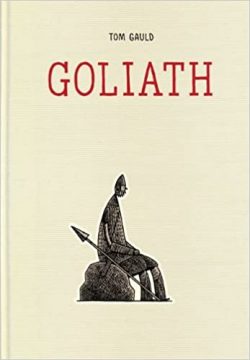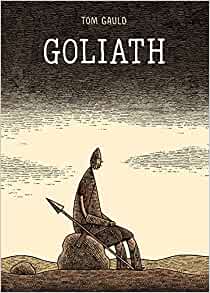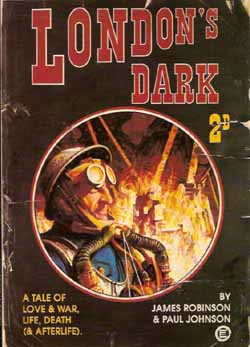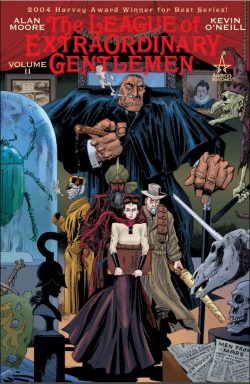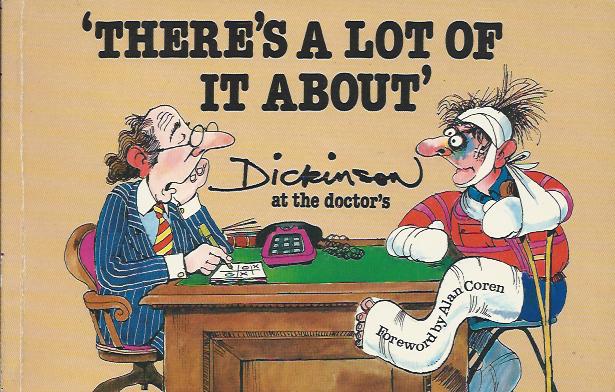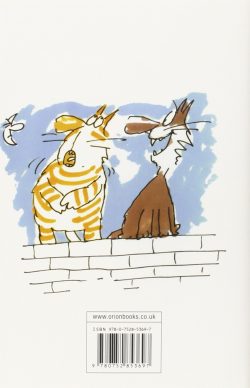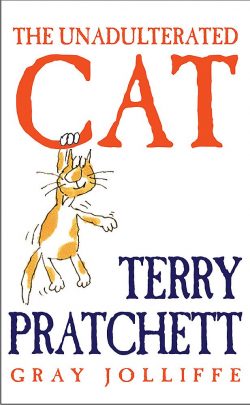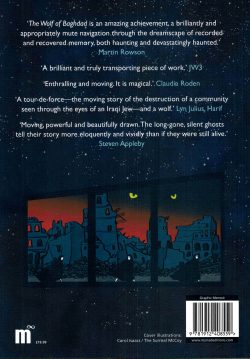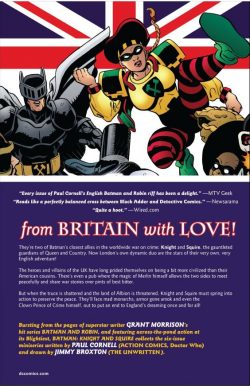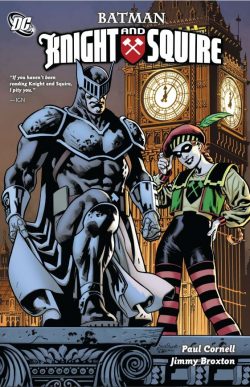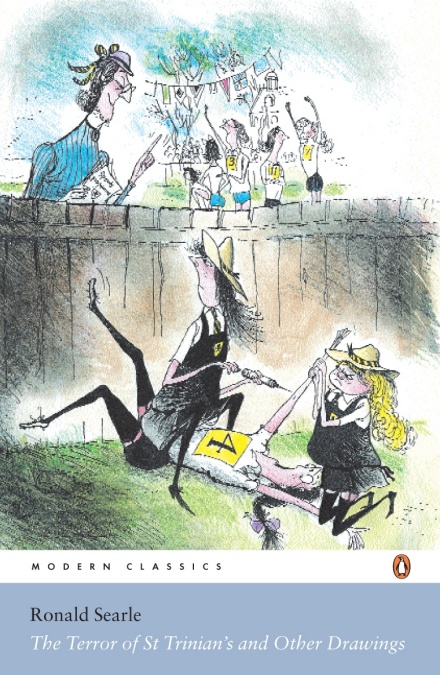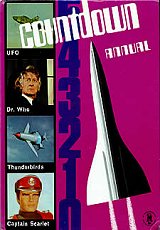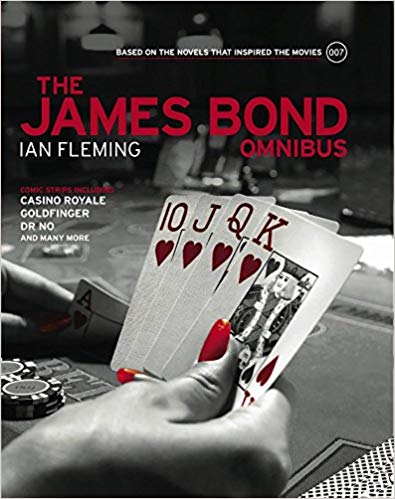
By Ian Fleming adapted by Anthony Hern, Peter O’Donnell, Henry Gammidge & John McLusky (Titan Books)
ISBN: 987-1-84856-364-3 (TPB)
It’s sad to admit but there are very few British newspaper strips to challenge the influence and impact of classic daily and Sunday “funnies†from America, especially in the field of adventure fiction.
The 1930’s and 1940’s were particularly rich in popular, not to say iconic, creations. You would be hard-pressed to come up with home-grown household names to rival Popeye, Dick Tracy, Buck Rogers or Flash Gordon, let alone Terry and the Pirates, Steve Canyon, or the likes of Little Lulu, Blondie, Li’l Abner, Little Orphan Annie or Popeye and yes, I know I said him twice, but Elzie Segars’s Thimble Theatre was funny as well as thrilling, constantly innovative, and really, really good.
What strips can you recall to equal simple popularity let alone longevity or quality in Britain? Rupert Bear? Absolutely. Giles? Technically, yes. Nipper? Jane? The Perishers? Garth? Judge Dredd?
I’d like to hope so, but I doubt it. The Empire didn’t quite get it until it wasn’t an empire any more. There were certainly very many wonderful strips being produced: well-written and beautifully drawn, but that stubborn British reserve plus a completely different editorial view of the marketplace (which just didn’t consider strips an infallible, readership-attracting magnet, as our American cousins did) never seemed to be in the business of creating household names… until the 1950’s.
Something happened in ’50s Britain – but I’m not going to waste any space here discussing it. It just did.
In a new spirit that seemed to crave excitement and accept the previously disregarded, comics (as well as all “mere†entertainment media from radio serials to paperback novels) got carried along on the wave. Just like television, periodicals such as The Eagle, the regenerated Dandy and Beano and girls’ comics in general all shifted into creative high gear …and so at last did newspapers.
And that means that I can happily extol the virtues of a graphic collection with proven crossover appeal for a change. The first 007 novel Casino Royale was published in 1953 and was subsequently serialised – after much dithering and nervousness on behalf of author Fleming – as a strip in the Daily Express from 1958. It was the start of a beguiling run of novel and short story adaptations scripted by Anthony Hern, Henry Gammidge, Peter O’Donnell and Kingsley Amis before Jim Lawrence, a jobbing writer for American features (who had previously scripted the aforementioned Buck Rogers) came aboard on The Man With the Golden Gun to complete the transfer of the Fleming canon to strip format. Thereafter he was invited to create new adventures, which he did until the strip’s demise in 1983.
The art on the feature was always of the highest standard. Initially John McLusky handled the illustration until 1966’s conclusion of You Only Live Twice and, although perhaps lacking in flash or verve, the workmanlike clarity of his drawing easily handled an astonishing variety of locales, technical set-ups and sheer immensity of cast members, whilst satisfying the then-novel directive of advancing a plot daily whilst ending each episode on a cliff-hanging “hook†every time.
He was succeeded by Yaroslav Horak, who debuted on Man with the Golden Gun, offering a looser, edgier style, at once more cinematic and with a closer attention to camera angle and frenzied action that seemed to typify the high-octane 1960’s. Horak illustrated 26 complete adventures until 1977 when The Daily Express axed the Bond feature (with a still-running adventure suddenly switching to The Sunday Express from January 30th until conclusion on May 22nd).
Later adventures had no UK presence at all, only appearing in syndication in European papers. This state of affairs continued until 1981 when British paper The Daily Star revived the feature with ‘Doomcrack’.
Titan Books re-assembled those scarce-seen tales – a heady brew of adventure, sex, intrigue and death – into addictively accessible monochrome Omnibus Editions, (sadly not available digitally at the present) wherein a dedicated band of creators on top form prove how the world’s greatest agent never rests in his mission to keep us all free, safe, shaken, stirred and thoroughly entertained…
In this premier no-nonsense paperback gem adapting 11 of Fleming’s best, the frantic derring-do and dark, deadly diplomacy commences with ‘Casino Royale’ as British operative Bond is ordered to gamble with and bankrupt Le Chiffre, a communist agent who has insanely embezzled away his Soviet masters’ operating capital.
The moodily compelling tale of tension that results depicts torture and violent death as well as oppressively suspenseful scenes of graphic gambling: heady stuff for newspaper readers of 1958, when it first ran.
Without pausing for breath or a fresh martini the Bond briefing segues straight into ‘Live and Let Die’ which sees 007 and US agent Felix Leiter tackle Mr. Big, another scurrilous commie agent, a devious genius who rules the Harlem underworld through superstition, voodoo and brutal force before, ‘Moonraker’ details the attempt by ex-Nazi officer Hugo Drax to drop a guided missile on London: a task made far simpler since the maniac has infiltrated the British aristocracy…
These newspaper strips come from a period when dependable John McLusky was developing a less formal approach, before going on to produce some of his best work. ‘Casino Royale; was the opening strip in a near 25-year run, and the somewhat muted artwork shows an artist still not completely comfortable with his task.
It was adapted and scripted by Anthony Hern, who had won the author’s approval after writing condensed prose versions of the novels for the Daily Express. Live and Let Die and Moonraker were both adapted by Henry Gammidge.
As McLusky settled in for the long haul, he warmed to the potentialities of the job with cracking tales of Cold-War intrigue and fast, dangerous living set in a multitude of exotic locales, providing here a welcome return to public gaze of some of the most influential – and exciting – comic strips in British history.
The adaptation of ‘Diamonds are Forever’ pits Bond against an insidious gang of diamond smuggling criminals, in an explosive if uncomplicated all-action romp before shifting into terse, low-key thriller ‘From Russia With Love’ (both courtesy of Gammidge & McLusky). The artist hit a creative peak with ‘Dr No’ perhaps because of the sparkling script from Peter O’Donnell (before he sloped off to create the amazing Modesty Blaise) with Bond returning to Jamaica to investigate the disappearance of two operatives and stumbling upon a plot to sabotage the American rocketry program.
These stories come from an age at once less jaded but more worldly; a place and time where the readers lived daily with the very real threat of instant annihilation. As such, the easy approachability of the material is a credit to the creators.
‘Goldfinger‘ faithfully adapts Fleming’s novel of the world’s most ambitious bullion robbery, so if you’re only familiar with the film version there will be a few things you’ve not seen before. The action fairly rockets along and the tense suspense is high throughout this signature tale.
Following that is ‘Risico’ as 007 is tasked with stopping a heroin smuggling gang whose motive is not profit but social destabilisation. Next is ‘From a View to a Kill’, a traditional and low-key Cold War thriller with Bond on the trail of a gang who have been stealing state secrets by ambushing military dispatch riders…
In the Roger Moore film incarnation Risico was folded into ‘For Your Eyes Only’ but here you get the real deal with a faithful adaptation of Fleming’s short story, wherein Bond is given a mission of revenge and assassination. Set in Jamaica with Nazi war-criminal Von Hammerstein as culprit and target for the man with a licence to kill, it is a solid piece of dramatic fiction that once again bears little similarity to the celluloid adventure.
The volume concludes with the then-controversial ‘Thunderball‘ adaptation. That particular tale was savagely censored and curtailed at the behest of Lord Beaverbrook, owner of the Daily Express. Five days of continuity were excised but what remains is still pretty engrossing comic fare and at least some effort was made to wrap up the storyline before the strip ended. In case you can’t recall: When Bond is sent on enforced medical leave, he stumbles into a deadly plot to steal nuclear weapons by a new subversive organisation calling itself Spectre…
These grand stories are a must for not only aficionados of Bond but for all thriller fans, as an example of truly gripping adventure uncluttered by superficial razzamatazz. Get back to basics, and remember that classic style is never out of fashion.
All strips are © Ian Fleming Publications Ltd/Express Newspapers Ltd 1987. James Bond and 007 are ™Danjaq LLC used under license from Ian Fleming Publications Ltd. All rights reserved.
